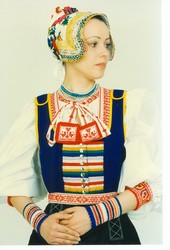Alena Rybáriková
The original folk costume worn by peasantry in the late 19th and the early 20th century disappeared from its original environment. Now, folk costumes have changed their appearance into dancing or stage costumes and are worn by dancers in the amateur and professional folk ensembles. Rural folk groups seeking to maintain the original folk costumes use original parts, however, they often must add new parts from the contemporary materials. Therefore, they certainly do not use original garments anymore. Folk ensembles have strived to develop new stage costumes for years. However, no unified method of designing and making stage costumes has ever existed.
Question is whether it is necessary to duplicate folk costume as close to the original as possible. How much stylisation is necessary? The ÚĽUV started to make folk costumes for folklore ensembles in the 1950s. Relatively well funded folk ensembles of that time ordered them. New folk costumes were produced in two ways. First – an ensemble chose a reproduction of the original garment for a new dance. Second method was used mainly by professional ensembles – a visual artist designed, after discussion with a choreographer, a folk costume. New folk costumes for popular folk ensembles such as Lúčnica, SĽUK, Vojenský súbor, PUĽS were designed using the latter method.
Several companies started to produce folk costumes in 1990. Ensembles may choose from various producers – price and not quality is important. Time has proved that the original garment cannot be copied to the last detail because original materials are not possible to obtain anymore and different production technologies are used now. Folk costumes for folklore ensembles may be designed in different ways. Main aspects are: 1. to collect as much information about a folk costume of a respective village or region as possible, 2. to cooperate with a visual artist or ethnographer who should define main characteristics of a garment, 3. to choose a material very carefully, 4. to maintain uniqueness of decorative patterns.
